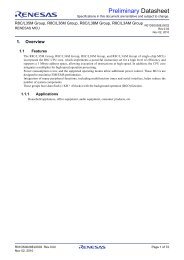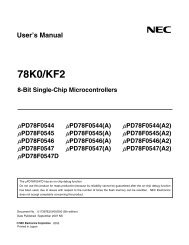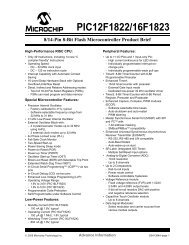xmega a3u - Elfa
xmega a3u - Elfa
xmega a3u - Elfa
You also want an ePaper? Increase the reach of your titles
YUMPU automatically turns print PDFs into web optimized ePapers that Google loves.
XMEGA A3U<br />
3. Overview<br />
The Atmel AVR XMEGA is a family of low power, high performance, and peripheral rich 8/16-bit<br />
microcontrollers based on the AVR enhanced RISC architecture. By executing instructions in a<br />
single clock cycle, the AVR XMEGA device achieves throughputs CPU approaching one million<br />
instructions per second (MIPS) per megahertz, allowing the system designer to optimize power<br />
consumption versus processing speed.<br />
The AVR CPU combines a rich instruction set with 32 general purpose working registers. All 32<br />
registers are directly connected to the arithmetic logic unit (ALU), allowing two independent registers<br />
to be accessed in a single instruction, executed in one clock cycle. The resulting<br />
architecture is more code efficient while achieving throughputs many times faster than conventional<br />
single-accumulator or CISC based microcontrollers.<br />
The AVR XMEGA A3U devices provide the following features: in-system programmable flash<br />
with read-while-write capabilities; internal EEPROM and SRAM; four-channel DMA controller,<br />
eight-channel event system and programmable multilevel interrupt controller, 50 general purpose<br />
I/O lines, 16-bit real-time counter (RTC); seven flexible, 16-bit timer/counters with compare<br />
and PWM channels; seven USARTs; two two-wire serial interfaces (TWIs); one full speed USB<br />
2.0 interface; three serial peripheral interfaces (SPIs); AES and DES cryptographic engine; two<br />
16-channel, 12-bit ADCs with programmable gain; one 2-channel 12-bit DAC; four analog comparators<br />
(ACs) with window mode; programmable watchdog timer with separate internal<br />
oscillator; accurate internal oscillators with PLL and prescaler; and programmable brown-out<br />
detection.<br />
The program and debug interface (PDI), a fast, two-pin interface for programming and debugging,<br />
is available. The devices also have an IEEE std. 1149.1 compliant JTAG interface, and this<br />
can also be used for boundary scan, on-chip debug and programming.<br />
The XMEGA A3U devices have five software selectable power saving modes. The idle mode<br />
stops the CPU while allowing the SRAM, DMA controller, event system, interrupt controller, and<br />
all peripherals to continue functioning. The power-down mode saves the SRAM and register<br />
contents, but stops the oscillators, disabling all other functions until the next TWI, USB resume,<br />
or pin-change interrupt, or reset. In power-save mode, the asynchronous real-time counter continues<br />
to run, allowing the application to maintain a timer base while the rest of the device is<br />
sleeping. In standby mode, the external crystal oscillator keeps running while the rest of the<br />
device is sleeping. This allows very fast startup from the external crystal, combined with low<br />
power consumption. In extended standby mode, both the main oscillator and the asynchronous<br />
timer continue to run. To further reduce power consumption, the peripheral clock to each individual<br />
peripheral can optionally be stopped in active mode and idle sleep mode.<br />
Atmel offers a free QTouch library for embedding capacitive touch buttons, sliders and wheels<br />
functionality into AVR microcontrollers.<br />
The devices are manufactured using Atmel high-density, nonvolatile memory technology. The<br />
program flash memory can be reprogrammed in-system through the PDI or JTAG interfaces. A<br />
boot loader running in the device can use any interface to download the application program to<br />
the flash memory. The boot loader software in the boot flash section will continue to run while<br />
the application flash section is updated, providing true read-while-write operation. By combining<br />
an 8/16-bit RISC CPU with in-system, self-programmable flash, the AVR XMEGA is a powerful<br />
microcontroller family that provides a highly flexible and cost effective solution for many embedded<br />
applications.<br />
8386B–AVR–12/11<br />
4

















